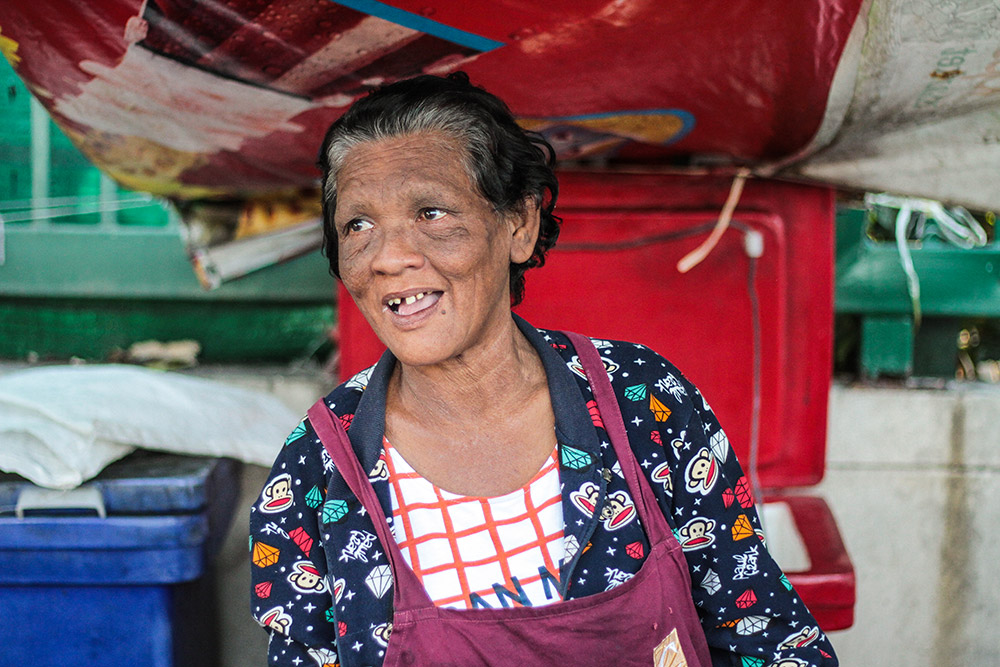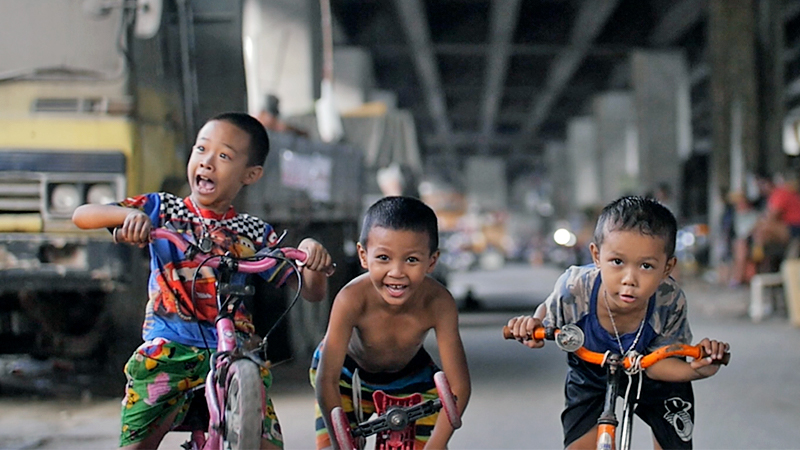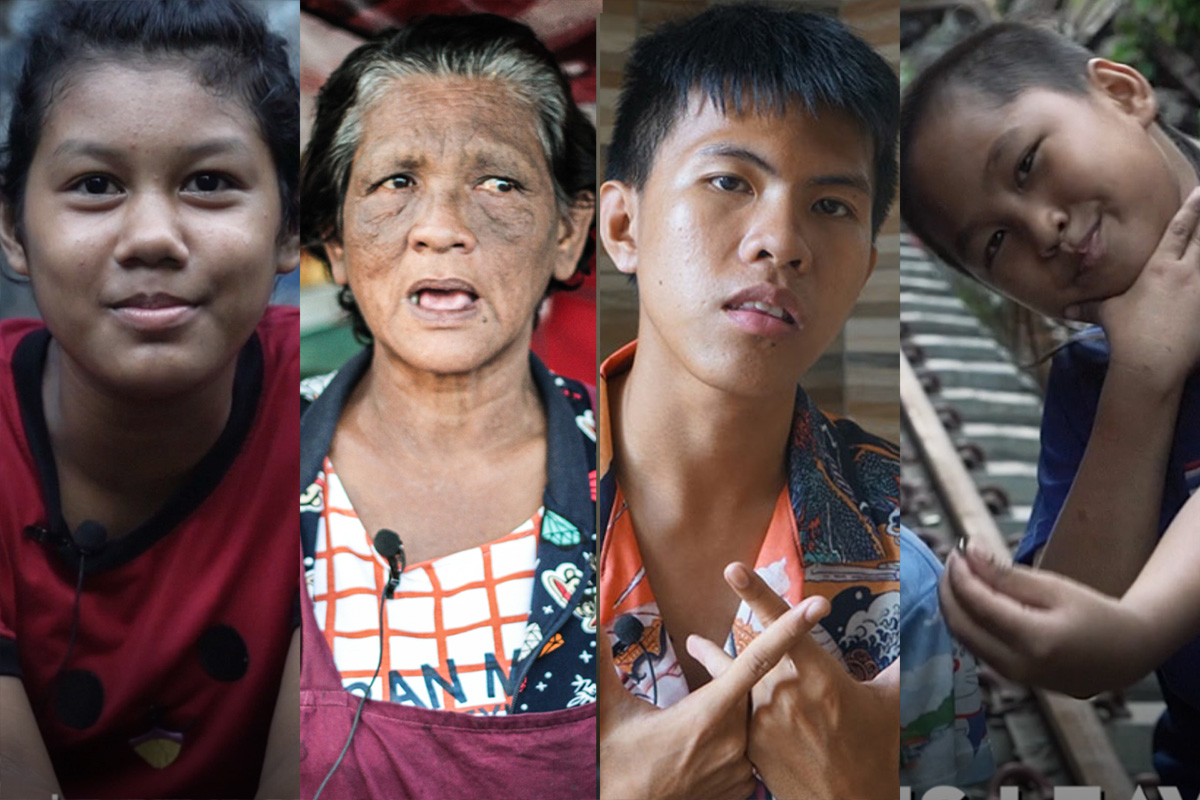It’s Friday afternoon and Ratchani Cheausuwan is tired. She’s been standing all day, selling selling snacks with her one usable arm. At the end of the other, her withered right hand is clenched in a permanent fist.
Now she’s waiting for school to let out. The passing children will be her last chance to earn a few baht to keep her daughter’s children fed and in school. Things weren’t always like this. Her daughter used to dance for foreigners in the neon glow of Soi Cowboy, bringing home thousands of baht, worth about US$150 every week. Now she’s broken too. Her first husband died young, and the second abandoned them after serving time in prison.
“To put it plainly, she lost it,” Ratchani, 56, said. “She stopped taking care of her kids. She just lived in her own world; she doesn’t deal with other people. She refuses to acknowledge anything and left me to shoulder all the responsibilities. Even her children, I have to pay for their school expenses. I have to pay 40 baht every day for them to travel to school.”
Her debts are insurmountable and growing. But any chance for the children to live unbroken lives means she has no choice but to push past the exhaustion and despair.
Multiply her story and its variations across the tens of thousands living in Bangkok’s largest slum, where such daily uncertainties and fears have been amplified by government plans to evict them all and “erase” their community to make way for a riverside mall.
When Ratchani was born in the early 1960s, the Khlong Toei community wasn’t the destitute sprawl it is today. The port it grew up around for the past decade was in its heyday. The lure of jobs had led many to accept an open invitation to settle the land under an incentive program that saw few pay rent.

Now just blocks away from the capital’s toniest bars and restaurants, Khlong Toei then was hardly considered Bangkok. Ratchani was about 15 when she ran away from an abusive home in the lesser developed On Nut area and followed her heart to a boyfriend living in Khlong Toei.
Self-reliance is a through line to her life learned early and painfully.
“When I gave birth, he didn’t come. He didn’t care,” she said of the boyfriend upon the birth of their son, who died five years ago of heart disease. “He said something like, “If you can take care of him, good. If not, just send him away.’ He was really cruel; he didn’t care about my feelings at all.”
Five years later, she remembers having to steal a towel from the hospital to carry her newborn daughter back home, alone.
“The hospital had to give me traveling money,” she said. “I didn’t even have a blanket to wrap around my baby.”
A decade ago she moved into a small, rundown residence on two floors in one of Khlong Toei’s several distinct communities. It’s there she supports the four of them by waking up at 4am to get the children to school and make her way to her stall.
“At about 5am, I start traveling to where I sell snacks. I don’t get home until nearly 7pm because I have to clean and wash up,” she said in a recent interview at her home. Despite repeating those 15-hour days five times a week, Ratchani still often comes up short, forcing her to borrow money from friends or loan sharks to get by.
“I owe people a lot of money right now — tens of thousands,” she said. “But I can’t make money to pay it back.”
FORCED OUT: A VR Experience Inside Bangkok’s Biggest Slum
Go beyond the headlines to meet Ratchani and step inside Bangkok’s Khlong Toei community in this mixed 3D/180 and VR/360 news feature. It’s best experienced via one of the many VR headsets available. Desktop computer users can use their pointing devices to look around. On a smartphone, use the on-screen joystick or, better yet, open it in the YouTube app and wave your phone around. Oculus, HTC Vive, Samsung Gear VR, Google Cardboard and other virtual reality headset owners should read how to best view YouTube 360 videos on those devices.
Boom to Bust
One of Bangkok’s 50 districts, Khlong Toei, or “pandan canal,” was named for the plant that grew along its banks.
The Port Authority owns the land where the community is located, and many consider that fact the end of discussion when it comes to evicting upward of 100,000 people living there. But that concept of land ownership is a relatively modern development established after the community was settled.
When the Siamese capital moved from Ayutthaya to Bangkok over two centuries ago, all land was owned by the king, who could lend, grant or gift it for use. Many of today’s neighborhoods and streets began as such royal gifts.
Up through the mid-20th century, Thailand had abundant land and scarce labor, and people were allowed to take possession of unused land by cultivating it, wrote David Feeny, professor emeritus of economics at Canada’s McMaster University.

Ownership rights based on use and exploitation were left intact when modern property laws involving titles and deeds were written in 1954, just as families were encouraged to settle around the Bangkok Port, which had opened a few years prior between two sharp bends of the Chao Phraya River.
Thailand’s rice boom led to the port’s construction being funded by the World Bank, and nearly all trade passed through it for decades. But even a large expansion couldn’t keep pace with demand, and the opening of a deep-sea port southeast of the capital at Laem Chabang heralded its decline.
Those who settled there to work the docks included immigrants from Laos, Cambodia, Vietnam and what was then Burma. They formed close-knit supportive neighborhoods, according to research by the Worcester Polytechnic Institute.
Today’s campaign to erase the slum, as one transport official put it, is the latest in a cycle almost as old as the community.
Three years after land-ownership laws were written, in 1957, the port authority sought to force out the dwellings to build a market and other buildings. It succeeded in relocating over 100 households from what’s called the Lock 6 area to Lock 12. The residents then organized against the expulsions, petitioning the prime minister and physically blocking demolition of homes.
Similar efforts were pushed back in the 1970s and 1980s. In 1983, residents departed voluntarily from some land for the port to develop under a 20-year land-sharing agreement under which claims of both landowner and settlers were recognized, according to Global Perspectives on the History of Squatting.
Many living there today remember what happened when a forced relocation failed following a 1991 chemical fire that left thousands sick and homeless. Many were rehoused about 30 kilometers away in government projects. But they couldn’t find work and most eventually returned to living in Khlong Toei.

It’s easy, he said, for those who’ve never experienced such poverty to say, “Oh they’re getting free land and they’re not happy about it?” But that betrays poor understanding of the basic realities faced by the poor, community organizer Garat “Duang” Peumrab said in August.
Today, there are nearly 30 communities living legally and illegally on the 500 rai (80 hectares) of land, according to Penwadi Sangchan, manager of Duang Prateep Foundation, an NGO that has played a key role in negotiations.
Evictions and campaigns against “encroachment” took on renewed fervor under the military government which seized power in 2014. With that, a new appreciation for waterfront real estate brought a particular zeal for redeveloping the Chao Phraya River. Many longtime riverside residents were cleared out and an unpopular plan to build boardwalks along its banks continues to be revived.
Beginning in late 2018, the port authority, an agency supervised by the Transport Ministry, began flaunting splashy plans to redevelop Khlong Toei into a riverside mall similar to the newly opened IconSiam, a luxury mall frequented by tourists.
But homes like Ratchani’s are in the way.
Inside, all four members of the family sleep together lined up on the floor. Ratchani sleeps closest to the door, followed by the two girls and then her 33-year-old daughter.
Mired in debt, she says the thought of moving is impossible.
“Last month, when I had to pay electricity for two months, it was THB1,700. I didn’t have money to pay for it. I had to borrow to pay for it,” Ratchani said, adding the interest for the informal loan was THB12 a day.
She said the THB800 disability stipend she gets every month from the government “does not help much.”

At her stall, she sells cups of soda – THB5 for children, 10 for adults – but isn’t sure she can find the cash to continue buying materials.
That many Bangkokians write off Khlong Toei as a drug- and crime-infested blight also hardens attitudes. Ratchani said that was true when she moved there in the early 1970s.
“When I first moved here, there were a lot of drugs. They were everywhere. There were some robberies. Thirty years ago, there were shootings right here,” she said, pointing to a small street immediately front of her snack stall.
She credits law enforcement for turning things around.
“Now Khlong Toei is nice. There are no worries. I don’t have to avoid the drug-infested areas anymore,” she said.
‘I will fight for it’
In late September, the Port Authority announced it would conduct a survey of Khlong Toei’s residents. It hired Mahidol University to ask them which of three compensation plans they preferred – moving into one of several thousand identical, small studio apartments to be built not far away, relocating onto bare patches of land on the distant outskirts of town or receiving one-time cash payouts.

What was advertised as a simple survey, however, was actually a legally binding contract.
As word of the eviction plans spread – community leaders say no attempt was made to include them in the process or assess their needs – a newfound sense of unity and resistance has grown.
Which is why many believe that, despite vows it will be gone within a year, Khlong Toei isn’t going away anytime soon.
One of those pushing back with his voice is an 18-year-old rapper with 11 fingers.
“Everyone loves Khlong Toei so they want to fight for it. … That’s why barely anyone has accepted the compensation options the government has presented to us,” Thanayuth “Book” Na Ayutthaya said.
Performing as “ElevenFinger” for the extra thumb on his left hand, the young social justice rapper wrote in his song Equality:
“There’s one thing you should invest in that will yield so much reward.
It’s the talented youths, the future of this nation.
For us to go far, you gotta develop our education.
Not just for show but sincerely do so…
“I just want to see everyone have equal rights.
You spend all your billions on your project strategy
While kids don’t even have money to study,
Isn’t it such a pity.
Fuck the government, you make the poor bleed.
Is this your promise to take care of your people?”
“I travel a lot, I’ve toured the country with my music but there’s no place like Khlong Toei,” Thanayuth said. “I walk down the street and there’s so much to eat and drink. I have so many friends here. … At the end of the work day, we all come and sit in the street and drink a beer. We listen to music in the street. … I frikkin’ love it, and I will fight for it.”
That sense of pride for Khlong Toei was shared by every resident Coconuts Bangkok has interviewed in recent months, regardless of age or occupation.
“I have a lot of friends here and there’s so many things that I love to eat. It makes me really sad that I have to move. I don’t want to go to the apartment building or Nong Chok, I’m not attached to it. … I love Khlong Toei,” 12-year-old Anisha Toesoongeun said.
“I was born and raised in this community, it breaks my heart to think about moving. … But whatever rules they make, I’ll follow. But if you want to ask me if I want to go, though, of course I don’t,” 36-year-old Pradit Choraphan said has he sat on the sidewalk, having a beer with his family.
Unintended consequences?
Thanayuth doesn’t believe the compensation is enough to support the hundreds and thousands of lives facing eviction. The rapper said people there know their history.
As his family’s been living and working in the neighborhood for about 50 years, he said his grandmother has told him about how similar, previous failed attempts decades earlier.
“I believe the same will happen with this project. Yes, there are more elaborate plans with models and everything, but I still don’t think it will work due to things like budgeting and the amount of people currently living in Khlong Toei,” he said.
He turns it around, saying the collapse of Khlong Toei as a system supplying labor to the port, markets, domestic care and more, would be devastating to the rest of Bangkok.
“Not only our system, but you know the people who work in downtown Bangkok; Sukhumvit, Thonglor or Asoke; we all come from Khlong Toei,” he said. “They are your maids, your garbage collectors or even your full-time office workers. In short so many of your rich communities have our residents as the foundation. If you kick us out, your economic system will collapse.”
In the meantime, the prospect of new government leadership coming to power and scrapping the redevelopment project is just as likely.
Nevertheless, Thanayuth said families such as his that can afford to consider options are doing so. His parents are saving money to buy a house southeast of the capital in Pattaya – “Just in case,” he says, “we have to start preparing early.”
Penwadi of the Duang Prateep Foundation is even less certain they’ll be able to remain.
“Some of the residents are convinced that they won’t be kicked out because they’ve been threatened many times. But I believe this eviction will happen.”
She says the economic forces are too hard to prevail against, and gives Khlong Toei five to 10 years.
“But I’m confident that the project will happen. Investments have been made, people have been paid and proposals have been submitted. Whether we like it or not this project is going to move forward,” she said.
Additional reporting and photography Chayanit Itthipongmaetee
Related:
Offered 200K to leave, Khlong Toei residents dig in their heels
Khlong Toei residents to be pushed on eviction options
‘Khlong Toei slum must be erased,’ official says
Forced out for new mall, Bangkok’s poorest fear life after Khlong Toei
Riverside Renovation: Chao Phraya promenade to start construction despite concerns
End of an era: Pom Mahakan residents face eviction as fort to be turned into public park


